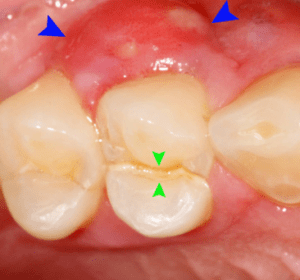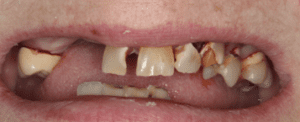Elderly Patients and Successful Strategies for Dental Emergencies
Founder of Joyful Dental Care – House Calls, Advocate, & Presenter
Geriatric House Call Dentist for over 15 years, Dr. Joy Poskozim speaks to Long-term Care Facility Administrators, Nursing Staff, Caregivers, and loved ones on the importance of oral health care as we age. Her goal is to share as much dental information as possible, thereby making it easier to communicate to traveling dentists on what oral health problems residents may have.
Having provided oral care for the geriatric community for over fifteen years, Joy understands that medical conditions – and the subsequent issues revolving around them – supersede oral care.
Oral care is imperative no matter our age.
For All The Caregivers And Loved Ones Out There: Get To Know Your Client’s Dentists!
 If they do not remember their dentist, or their dentist has retired, etc., it is imperative that they are seen for an oral exam and cleaning – regardless of where they are living: Independent Living, Assisted Living, Skilled Care, Memory Care, Hospice, etc.
If they do not remember their dentist, or their dentist has retired, etc., it is imperative that they are seen for an oral exam and cleaning – regardless of where they are living: Independent Living, Assisted Living, Skilled Care, Memory Care, Hospice, etc.
The more you can learn about this person’s overall health, the better they will be, and the better off they will be if a situation occurs. Especially in the mouth!
How can one tell if someone is having a mouth issue? Watch how they eat!
If someone starts to:
- only use one side of their mouth to chew;
- reject certain foods that may be harder to chew;
- remove their denture(s) before/after eating;
- not want to put their dentures in the morning to eat.
Chances are, these people are having an issue with their mouths – especially if they begin to lose weight from not eating enough.
When I am called, the first thing I am going to look for is a source of pain:
- Inflammation
- redness
- swelling
- Tooth Mobility
- broken tooth
- broken prosthesis (denture/partial denture)
Gingivitis and Abscesses
I was once called into a memory care nursing home due to a dental abscess. Since this was not a patient of record, I had to see the patient first before I could do any form of treatment, like prescribe meds. Dental abscesses are considered an emergency since they can lead to sepsis, which can be fatal, especially for someone who is immunocompromised.
 This image is exactly what I saw: red swollen gums, otherwise known as “marginal gingivitis”. An abscess is going to look like a red target lesion, like the store logo. White in the middle, red borders, and more above/below one tooth. This image is of someone who doesn’t have their teeth brushed regularly on a consistent basis.
This image is exactly what I saw: red swollen gums, otherwise known as “marginal gingivitis”. An abscess is going to look like a red target lesion, like the store logo. White in the middle, red borders, and more above/below one tooth. This image is of someone who doesn’t have their teeth brushed regularly on a consistent basis.
Gingivitis – inflammation of the gingival soft tissue (gums) – is a chronic condition that stresses the immune system. 85% of the US population has some type of gingivitis: mild, moderate, or severe. However, since our immune systems are centered in the brain, the less stress the brain has to deal with, the less chance of other issues arising, such as one of the dementias.
What Is The Best Way To Get Rid Of This Issue?
Best way to get rid of this issue? Brush teeth twice daily – after breakfast and directly after dinner or before this person sundowns. I did prescribe a medicated mouthwash to help control the inflammation so that the gums wouldn’t be as painful.
Unfortunately, these gums hurt too much for me to provide a cleaning at this first emergency appointment. Will give this case at least two weeks up to three months before I go back and try to perform treatment for them.
 This upper middle tooth in this picture has a horizontal fracture in it, causing inflammation, as seen by the blue arrows. This inflammation would only be able to be seen if the upper lip is lifted to see what may be causing pain.
This upper middle tooth in this picture has a horizontal fracture in it, causing inflammation, as seen by the blue arrows. This inflammation would only be able to be seen if the upper lip is lifted to see what may be causing pain.
Fractured teeth are HORRIBLY painful – even if your client/patient/loved one is nonverbal.
This tooth would have to be extracted as the only form of treatment, but if the person has been experiencing pain for a while – over 3 days – this person may do better first with a round of antibiotics to help control the inflammation for better numbing results.
This Is A True Dental Abscess,
And It Can Be Fatal. It Can Cause.
Dental abscesses are first controlled by dental antibiotics.
If it goes away, we will continue to monitor it over time to make sure it doesn’t come back. If it does, the tooth needs to come out with a follow-up round of another type of antibiotics.
Tooth fractures are very common in my neck of the woods.
Over 30% of the US female population has gone undiagnosed with osteopenia or osteoporosis. Teeth and bones are cut from the same cloth, and post-menopausal women are more likely to have brittle teeth. Biting into something at age thirty vs biting into the same thing at age eighty can cause completely different directions of forces depending on tooth loss, tooth mobility, etc.
Can this be fixed in someone’s home if home-bound?
 Yes — if this is truly caused from trauma and not by underlying bacteria (cavity). One of the hardest conversations I have with loved ones is when I see this due to biting onto a utensil or something that doesn’t belong in the mouth (memory care), and I tell them that nothing can be done. The “pro” is that this patient most often doesn’t even know they broke a tooth.
Yes — if this is truly caused from trauma and not by underlying bacteria (cavity). One of the hardest conversations I have with loved ones is when I see this due to biting onto a utensil or something that doesn’t belong in the mouth (memory care), and I tell them that nothing can be done. The “pro” is that this patient most often doesn’t even know they broke a tooth.
The “con” is that the family will have to look at their loved one and live with the realization that this tooth cannot be fixed due to not being able to handle having the tooth fixed under normal circumstances.
Yes, this tooth can be fixed under significant oral sedatives, but studies have shown that these sedatives can also make dementia symptoms worse. Most of the time, if the tooth fractured under true trauma, it can be like this, safe and healthy for the rest of the person’s life.
 As we get older, the nerves in our teeth resorb, becoming less sensitive to hot, cold, sweets, and issues like the one above. The tooth on the right is missing part of its tooth-colored plastic filling. Anyone approximately 60 and under would definitely feel this and want to get their tooth fixed.
As we get older, the nerves in our teeth resorb, becoming less sensitive to hot, cold, sweets, and issues like the one above. The tooth on the right is missing part of its tooth-colored plastic filling. Anyone approximately 60 and under would definitely feel this and want to get their tooth fixed.
A lot of the nursing home residents I see will have had at least one tooth missing a filling due to normal usage without any pain at all. When we age, our teeth become shorter, thus collapsing our bites. This puts more pressure on our back molar teeth, causing the filling like above to pop out. If the tooth is asymptomatic, I would apply a fluoride varnish and leave it alone. If I can get this nursing home resident to get to my practice, I would definitely refill.
When A Crown Comes Off
 The best kind of call I can get for a dental emergency is when a crown comes off due to the cement wearing away, and the nurses have saved the crown, and I can come and recement. Never throw away anything that comes from the mouth that is not obviously food or plaque!
The best kind of call I can get for a dental emergency is when a crown comes off due to the cement wearing away, and the nurses have saved the crown, and I can come and recement. Never throw away anything that comes from the mouth that is not obviously food or plaque!
Even if I cannot recement the tooth back on, due to new decay, for example, I can see what came out, so I have an idea of what I may be able to replicate to put back in. That being said, if the crown is lost and I see a tooth like above, I can take an impression and make a brand-new crown for them that I can recement.
Ugly Smiles Or Extractions
The hardest conversation I have with loved ones is when I can honestly tell them that the dental issue will not literally kill them but will cause them to have an ugly smile for the rest of their lives due to whatever medical conditions they may have that prevent me from performing treatment for them.
 If a tooth does need to be extracted and this person is on blood thinners, I do have to have the prescribing physician fill out a Medical Clearance form stating what type of protocol their patient needs to be off/on for the dental extraction. Antibiotics will usually be prescribed while waiting for the completed form to come back, so it is of utmost importance to know if your client/patient/resident is allergic to any antibiotics.
If a tooth does need to be extracted and this person is on blood thinners, I do have to have the prescribing physician fill out a Medical Clearance form stating what type of protocol their patient needs to be off/on for the dental extraction. Antibiotics will usually be prescribed while waiting for the completed form to come back, so it is of utmost importance to know if your client/patient/resident is allergic to any antibiotics.
Any questions/concerns/comments? Never hesitate to contact me!
 Submitted by Dr. Joy Poskozim DDS FSCD CDP
Submitted by Dr. Joy Poskozim DDS FSCD CDP
Founder of Joyful Dental Care – House Calls, Advocate, &Presenter
Geriatric House Call Dentist for over 15 years, Dr. Joy Poskozim speaks to Long-term Care Facility Administrators, Nursing Staff, Caregivers, and loved ones on the importance of oral health care as we age. Her goal is to share as much dental information as possible, thereby making it easier to communicate to traveling dentists on what oral health problems residents may have.



